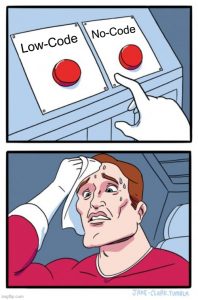I Want To Learn More About Low-Code. Where Should I Start?
I Want To Learn More About Low-Code. Where Should I Start?
Appian, Five.Co, PowerApps, Outsystems, Mendix, Bubble, Retool, Unqork, Zappier, Zoho, AppGyver, AppSheet. The list of no-code & low-code tools grows longer by the day. What’s the right place to start?

The list of no-code and low-code vendors seems to get longer by the day. Finding the right starting point can be difficult for anyone new to the industry.
Here are three essential questions for selecting the right no-code or low-code tool:
1. What’s The Problem You Are Trying To Solve With Low-Code?
This is the first question to ask. What are you trying to build with no-code / low-code? A website? A web application? Automation? Is your website or web app designed for use by consumers or business users? Each platform is suited for a different use case. Define your problem before trying to find the right tool.
2. What Are Your Programming Skills?
Once you have defined the problem that you are trying to solve, ask yourself what your skills are. Here is a shortcut: do you know SQL and relational databases? If yes, focus on low-code platforms (Five, Retool, Outsystems, Mendix, etc.). If no, focus on no-code platforms (Bubble, AppSheet, Honeycode, etc.). Generally speaking,
- If you have never written code before, you will be amazed by what you can achieve in a pure no-code approach.
- If you are a professional developer, you will be amazed by the speed of low-code development, whilst still being able to write full code where necessary.
3. What Is Your Budget For A Low-Code Tool?
Few developers take into consideration budget when exploring tools. Most tools are available for free anyway, so cost is only a secondary consideration. Why bother worrying about cost now, when the question only becomes relevant down the road? The answer is simple: “There’s ain’t no such thing as a free lunch”.
Understanding what running an application will cost you, is one of the best ways to a platform’s suitability. Ultimately, no-code and low-code tools are supposed to generate savings in time and cost. Otherwise, what’s the point of replacing your current dev environment with a new development tool? Our advice: explore the pricing structure of tools even before signing up for a free version.
A simple rule of thumb for selecting the right low-code tool is this:
- When you can accurately estimate the number of end-users, end-user-based pricing makes sense. This is typically the case when you build an application for internal staff. The headcount in your department or company is not going to grow by 1000% overnight. End-user-based pricing enables you to accurately predict the cost of running the software. However, even then it is worth thinking twice about end-user-based pricing. Being charged by the end-user might create the wrong incentives for the roll-out of your application: every additional end-user will cost extra, so there is a risk of cutting corners and designing the application in a way that keeps the number of end-users more restricted than may make sense from a business point-of-view.
- When you cannot accurately estimate the number of end-users, end-user-based pricing does not make sense. Let’s say you want to build a marketplace or social network that could go from 100 to 1 million users overnight. Then end-user-based pricing does not make sense. Imagine having to pay US$15 for every additional user that signs up. You would go bankrupt as your app succeeds. A fixed price per application, or per server capacity is the right underlying pricing model for applications where you cannot predict the number of end-users accurately.
To read more about low-code and its cost benefits, also check out Infoworld’s Guide on “How To Choose A Low-Code Development Environment“.
Equipped with these three simple questions, you will be ready to select the right platform for you!
If you’d like to learn more about low-code software engineering, check out our other blog posts on https://five.co
Topics covered are:
- Are low-code and no-code the same?
- What are the limits of low-code and no-code?
- And, will low-code make developers redundant?


